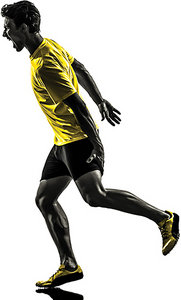Want to set yourself apart from the crowd in the competitive world of sports injury management? Perhaps you want to venture into taking care of athletes and focusing more on sports-related injuries.
How can you target that market? Why should they come to see you for care? These are questions you need to ask in order to become a go-to source for this skyrocketing market. It's not enough to just be good at what you do. Consumers assume you are good. By following a few simple do's and don'ts, you can get in the game of sports injuries.
It's a #hashtag world. Iconic, billion-dollar, name-brand companies are using hashtags in their marketing campaigns. Every product from food, cars and clothing, to electronics and even pharmaceuticals, is in on the hashtag mania. Why? Because people expect to see it in your marketing. Simply put, these days, if you don't hashtag, you are virtually invisible to the world.
Now, you may be thinking, I can't hashtag, I'm a professional. That's a big mistake. You are also a business, a brand and an entrepreneur. Learning to hashtag is essential to business and professional success.
So, what exactly is a hashtag and how can you use it effectively to get into the game of sports injuries? A hashtag is a label for content. It helps others who are interested in a certain topic quickly find content on that same topic. A hashtag looks something like this: #shinsplinthelp or #runninginjuries. Hashtags are used mostly on social media sites. They started on Twitter. (You are on Twitter, right?), but now you can use hashtags on any social platform, such as Instagram, Facebook, Pinterest and Google+.
Anyone sharing content on a relevant topic can add the hashtag label to their message. People (potential patients) searching for that topic can search for your hashtag to find your message.
Hashtags also can be put on physical products used in marketing your service: business cards, shirts, hats, pens, mugs, posters, etc. Hashtags can include your business name, as well as a catch phrase for your marketing campaign (#xyzchiropractic or #runpainfree). You can and should use both.
Here's a quick example of how you can use hashtags to promote your sports injury message and locate potential patients in your chosen market. If you like working with runners and treating common injuries in that activity, write a blog post or article about a common running injury such as shin splints. Hashtag in the post and about the post with your message (#shinsplints, #runpainfree, #helpforshinsplints, #Ihateshinsplints). Make the tags relevant, but also fun. You can create any phrase you want for the tag. Do both! Why? #shinsplints casts a wider net in your market, but then you want to zero in on your uniqueness by making a hashtag your own, such as #goodbyeshinsplints.
Hashtag all pictures. Join Instagram today! Instagram is a social media platform designed around sharing pictures and short 15-second video clips. It's the platform for younger demographics. It's become more popular than Facebook. Take a short video or picture of a treatment of runners and post with your hashtag. Your patient, who is probably on Instagram, will repost the picture to their followers and you will reach thousands of people for free. How can you beat that?
DON'T Market to Every Sport or Injury
In their book The ONE Thing, authors Gary Keller and Jay Papasan say: "Think big. Do small." Brilliant advice when it comes to success. If you try doing anything and everything without focus, you easily burn. Doing smaller things well is much more productive than doing many things halfway. Don't confuse busyness with productivity. If you market to everyone, you market to no one.
We know chiropractic can help everyone, but market it that way and you lose the attention of the marketplace. Narrow your market and you become more desirable. Sound counterintuitive? Yes, and thats exactly why most people don't do it.
You must choose a specific sport and/or sport-specific injury to focus your attention. If you like treating runners, target your campaign toward that demographic. Start searching blogs, Facebook groups, LinkedIn groups, and Instagram with the hashtag #running. Next, focus on specific injuries that wreak havoc for the majority of most participants. People who love running often suffer from shin splints, plantar fasciitis and ITB syndrome. Begin doing hashtag searches for those conditions. Post about those conditions on your website and social media.
People need to learn that you are the go-to person for help. I once read an article about a successful doctor who was known as the "Shoulder Guru." Whenever anyone asked, "Who is the best for shoulder injuries?" her name would always come up. When asked how she attained such status, her reply was, "I just started calling myself the shoulder expert." She attracted the target market by marketing herself as the one to consult with for shoulder injuries.
Focus your marketing and demographic campaign to one niche for 90 days and monitor the results. Track your stats so you know definitively if efforts are paying off. It's highly recommended you target conditions you enjoy treating. When you are passionate about something, you go the extra mile.
DO Get Specialized Training
Just saying you specialize in a condition or injury will not be enough when you have to deliver the goods. When you focus on an injury, immerse yourself in learning anything and everything about the condition. Take specialized courses on your niche within your profession ... and outside of it.
A mistake often made in specialization is not experiencing how other disciplines work within the scope of an injury. Say you want to specialize in sport-related shoulder injuries. Take courses on the shoulder taught by a chiropractor, physical therapist, massage therapist, athletic trainer, strength and conditioning specialist, sports physician, orthopedic surgeon, acupuncturist, movement therapist, etc. Stepping outside our comfort zone is how we grow. You can take pieces from each discipline and incorporate them into your assessment, evaluation, treatment, rehabilitation and therapy.
One golden nugget of information can make a significant impact on your programming. Along the way, you will build up a nice professional network of professionals who may be cross-referral sources. Working together for the benefit of the patient is a powerful way to stand out from the crowd. Patients love to see a team effort from their professional network. No one becomes successful alone.
You may also niche a niche with specialized training. If you like treating shoulders, focus your attention on impingement syndrome. More and more impingement syndrome patients will end up finding their way into your office. Action step: Search for three specialized courses from different practitioners in your chosen injury / sport and book them into your calendar. Set aside a budget for continuing education. If CEU credits are not available for chiropractors, go anyway! Go-to experts are concerned with being the best; getting credits is far down on the priority list for top performers.
DON'T Follow the Crowd
Why be like everyone else? That's boring – and no one pays attention to boring. The latest brain research is showing how the brain is programmed for novelty attraction. Something must stand out and be relevant for your brain to pay attention. Author John Medina, in his book Brain Rules, says, "What we pay attention to is profoundly influenced by memory. Our previous experience predicts where we should pay attention. Culture matters too. Whether in school or in business, these differences can greatly affect how an audience perceives a given presentation."
How can you stand out from the crowd? Offer services that deliver powerful results clinically and are not offered everywhere else. Go into most offices and you find electrical muscle stimulation, ultrasound and exercise equipment. What's unique about that? Try adding high-intensity laser therapy, kinesiology taping, Indian clubs, kettlebells, ground-based body-weight movement rehabilitation exercises, etc. Offering alternatives that people have never experienced introduces a new stimulus to the brain, so patients often feel better simply because you've introduced something different.
Remember, previous experience is a predictor of expectations. The human body is designed for adaptation. Stimulating damaged tissue or dysfunctional movement patterns with new therapies can have profound impact on overcoming treatment plateaus.
Athletes are proactive about their care plans. They want to be involved in recovery so they can get back to doing what they love, and do it better than ever. Laser therapy has been shown to speed the healing process of damaged tissue. Kinesiology tape offers stability and support during movement outside of the office. Indian clubs offer a challenging neurological-patterning exercise that crosses over to improved athletic timing and performance. Body-weight training teaches athletes how to control the ultimate machine: their body. If you can't control your own body, you are at a competitive disadvantage. Set yourself apart and offer more than the clinic next door.
DO Put Yourself Out There
Make yourself available to athletes. One of the core aspects of a successful sports practice is availability. Athletes often play games on the weekends, and injuries are more likely to occur during competition than during practice. That means you should have weekend or urgent-care hours when necessary to accommodate athletes. Availability is a game changer for your practice.
Your practice should be very service-oriented. Athletes involved in competition should have your direct off-hours contact number or your answering service instructed to make them top priority. Most of the time, they will not even use the service, but simply knowing you are there makes a difference.
Create a sports-program hotline for trainers as well, so they can call whenever someone is injured and make an appointment to see you right away. Be proactive in communicating with coaches and trainers of athletes. Coaches love when they know quickly what's wrong with their players. By being available and keeping communication streamlined, you can provide efficient care.
Do public lectures, but do them at athletic events in conjunction with offering on-the-spot care. For example, set up a table at a local Spartan Race; provide assessments, treatments, etc., and hook yourself up to a mic so you can do educational talks on particular topics. I once set up at a running race and brought foam rollers and stretch straps with me. I gave a talk on loosening up hips for running and had people on the ground foam rolling and stretching. Drew a crowd very quickly – and I ended up selling rollers and straps!
Even though you may not gain patients immediately from a lecture, this is a long-term strategy for sharing your knowledge and building your reputation in the community.
Instant Action Plan Recap
- Join Instagram today. Start using #hashtags for everything.
- Narrow your focus. Pick your niche condition and sport.
- Book a specialized course outside of your profession this week.
- Get new equipment (laser, Indian club, kinesiology tape, etc.).
- Set up a hotline for your athletes (start with your cell).
Click here for more information about Perry Nickelston, DC, FMS, SFMA.






